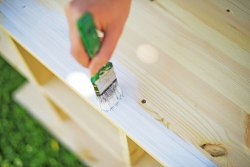Making your own furniture can save you lots of money, and the satisfaction of a job well done is well worth the effort.
 Taking the time to assemble and finish your projects professionally is the difference between an item looking made or bought.
Taking the time to assemble and finish your projects professionally is the difference between an item looking made or bought.Having said that, you want to make furniture that prompts your family and friends to say, "Where did you buy that?" not, "Did you make that?". There's a big difference between the two.
Taking the time to assemble and finish your projects professionally is the difference between an item looking made or bought. This is something you should bear in mind when you want to take shortcuts.
Get some tips…
1. Think it through
Before you start any project, you need to determine whether or not you have the skills to take it on. Once you’re done, make sure to give your project a professional finish.
Try and complete projects that are reasonably simple, and use tools that you already have. Before you start any project, look at the skill level and read through the instructions. This way, you’ll be able to decide whether or not it’s something you can do.
Nowadays, we have access to a wide range of tools and materials that you will find at your local Builders Warehouse or Builders store. Where materials are not available locally, you’ll need to consider local substitutes.
 Making your own furniture can save you lots of money, and the satisfaction of a job well done is well worth the effort.
Making your own furniture can save you lots of money, and the satisfaction of a job well done is well worth the effort.Consider the cost of materials to ensure that your particular project won’t end up costing more than a bought item, unless you’re using unique materials and the value of the finished project is worth the expense.
2. Have the right tools
First and foremost, it is important to have a decent set of tools. Deciding what tools you need can be tricky, especially with the vast array of power tool options available today.
The choice of tools is a personal one as there are homeowners who enjoy working with a Kreg Pocket Hole Jig and others that would rather use a Biscuit Joiner. If you can't afford to splurge on tools like these, you can always go back to basics and use older alternative methods for joining pieces together. These tools just make life, and your projects, easier.
Make your own dining table, which can cost as little as R6 000. With the right tools and materials, you could make your own dining table for R2 000. That's a huge saving by anyone's standard, and you can customise the finish so that it fits in with your décor.
3. Assess your skill level
 Finishing your projects once they’ve been assembled will ensure that they look beautiful.
Finishing your projects once they’ve been assembled will ensure that they look beautiful.When you decide to make your own furniture, you need to consider whether or not you have the skills.
Without the necessary skills, taking on a project that ends up looking like a 'bought' piece and not a 'made' piece is not easy.
Start small with projects that incorporate a variety of tools and techniques to gain confidence using power tools and understanding basic jointing and finishing methods. Make a stool or kiddies chair using basic power tools to get yourself started.
Once you’re confident, move on up to larger, more difficult projects.
4. Finishing your projects
Finishing your projects once they’ve been assembled will ensure that they look beautiful.
It's not about slapping on a couple of coats of paint and hoping for the best. You have to be prepared to put in the time and effort to apply a professional finish.
Get to know what products are available by walking the aisles at your local Builders or hardware store.
 Practice does make perfect so be patient while you hone your DIY skills over time.
Practice does make perfect so be patient while you hone your DIY skills over time.Know what is obtainable before you start, so that you have time to look at substitutes to achieve the finished look that you want.
5. Ask for advice
Don't be afraid to ask for advice if you’re unsure about the correct way to proceed.
Consider that we all have to start somewhere.
Practice does make perfect so be patient while you hone your skills over time.
Persevere and you’ll soon realise that you can make your own furniture.
Article courtesy of www.home-dzine.co.za.








